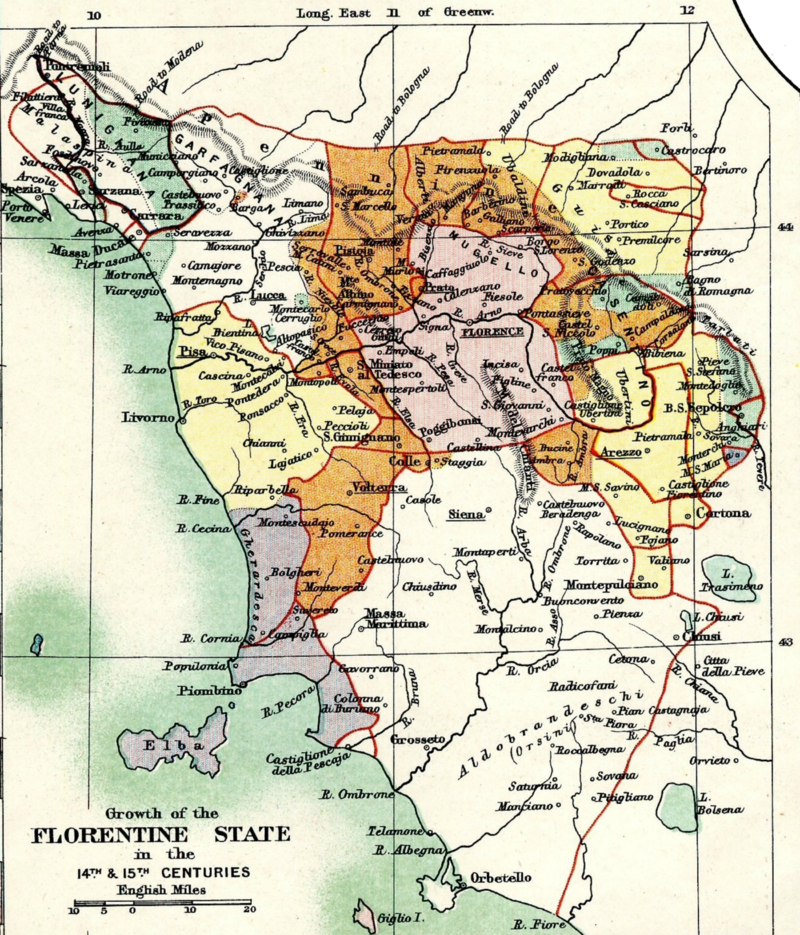What was the Florentine Republic?
Learning about the Renaissance and curious to know about one of its major centers? Learn more about the Republic of Florence!
Today, the Italian peninsula is (for the most part) unified in the single country of Italy. However, the existence of a country called Italy is a relatively recent phenomenon. Between the fall of the Roman Empire and the mid-1800s, the country of Italy did not exist. Instead, the Italian peninsula was covered by a collection of different states. We can see some remnants of this older system of smaller states today in the very small countries of San Marino and Vatican City, which are also located on the Italian peninsula.
In this period between the fall of the Roman Empire and the creation of the Italian state, the peninsula was divided among various political entities. Some of their names are still familiar to us today: the Duchy of Milan, the Kingdom of Naples, and the Republic of Venice. Over the centuries, some states rose to power and others fell out of power; territories exchanged hands between different states. For the most part, though, the history of the Italian peninsula was the history of these separate states.
One of these major states on the Italian peninsula was the Republic of Florence. The Republic was centered around the city of Florence (a city that still exists today) and also included surrounding cities, towns, and countryside. The map above shows the borders of the Republic of Florence in the 14th and 15th centuries. As you can see, the Republic controlled a vast area of land in the northwest of the Italian peninsula, far beyond just the city of Florence (which you can see directly in the center).
The Republic was first formed in the 12th century, and it began to flourish shortly thereafter. Especially, Florence became powerful through the strength of its currency (the florin) and the strength of its banking industry.
The 1400s marked a time of great prominence for the Republic. Following the social upheaval of the Black Death the century before, new ideas and artistic endeavors flourished in the city. Building on its earlier reputation as a place of famed writers, Florence also became a center for new styles of art, known as the Renaissance. The Renaissance tried to recapture the artistic knowledge and styles of ancient Greece and Rome, emphasizing perspective, realism, and classical forms. Famous artists who worked and studied (at least for a time) in Florence include Donatello, Sandro Botticelli, and Leonardo da Vinci. Florence also became a center for Renaissance architecture. The looming dome of the Cathedral of Florence still remains the largest masonry dome in the world. To construct the dome, architect Filippo Brunelleschi needed to invent devices, many of which inspired Leonardo da Vinci during his time living in Florence.
The Medici Bank, which for a time was one of the leading banks in Europe, and launched the Medici family to a leading position in Florence, also saw some of its heights during these years. Some heads of the Medici family also became leaders of Florence: figures like Cosimo de’ Medici and Lorenzo the Magnificent were also political leaders of the city.
While today, many of these Renaissance ideas and artworks are held in high esteem, the opulence of these times also sparked fierce backlash. The priest Girolamo Savonarola briefly led some Florentine citizens in a fight against such vanities at the end of the 1400s.
The Republic of Florence continued into the 1500s, slowly transforming during these years. In the 1530s, after a loss to the Holy Roman Emperor, the Medici family became the rulers of Florence by heredity—a conflict with the previous idea of republican rule in Florence. By the 1560s, the Republic was abolished, replaced by the Grand Duchy of Tuscany. The Grand Duchy of Tuscany ceased to exist in the 19th century, in the wider process of the unification of Italy.
Want to Study History in Depth?
Circa teaches critical thinking skills to high school students so that they can study the past themselves.


